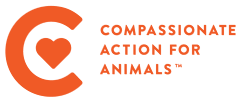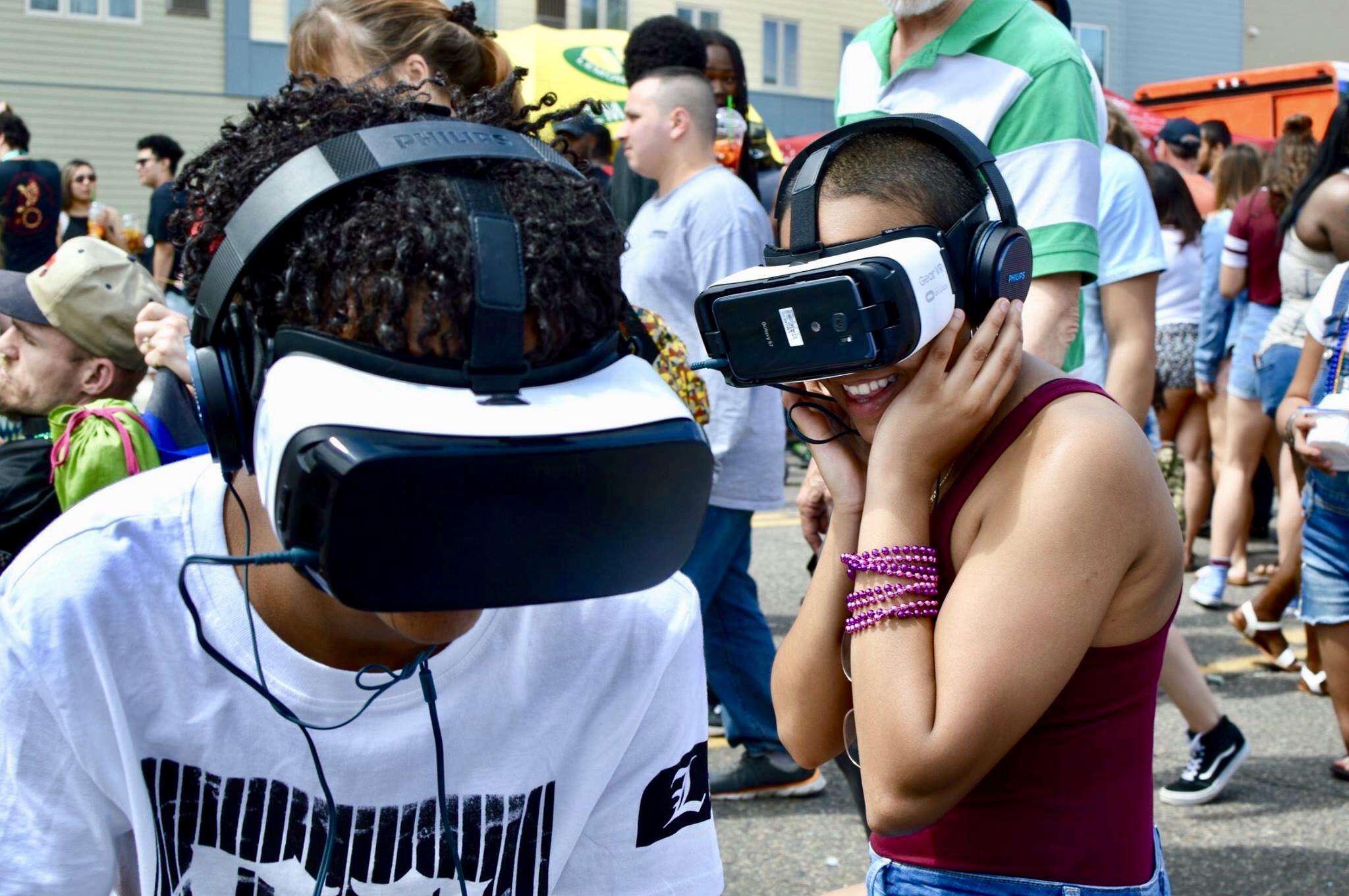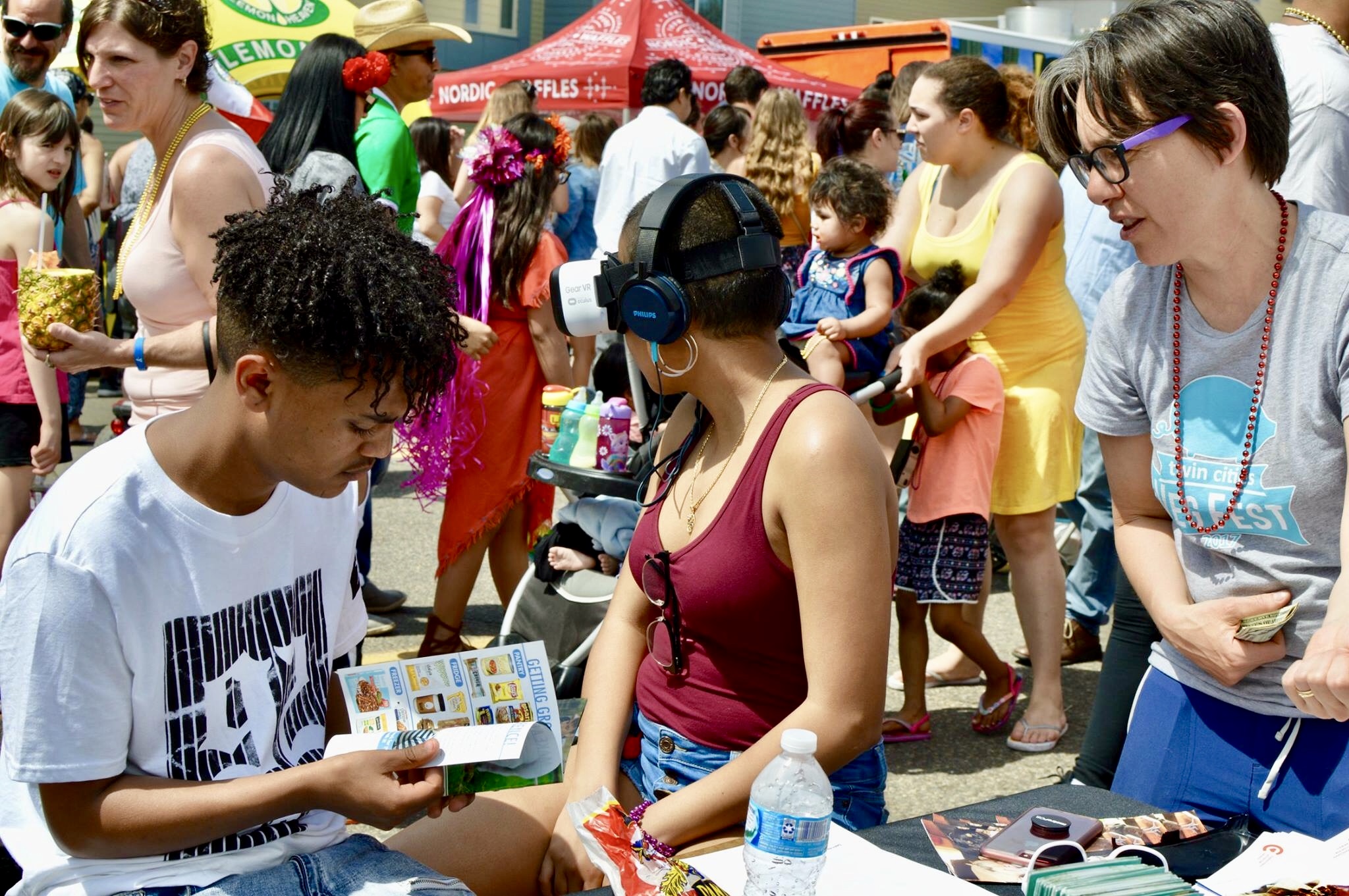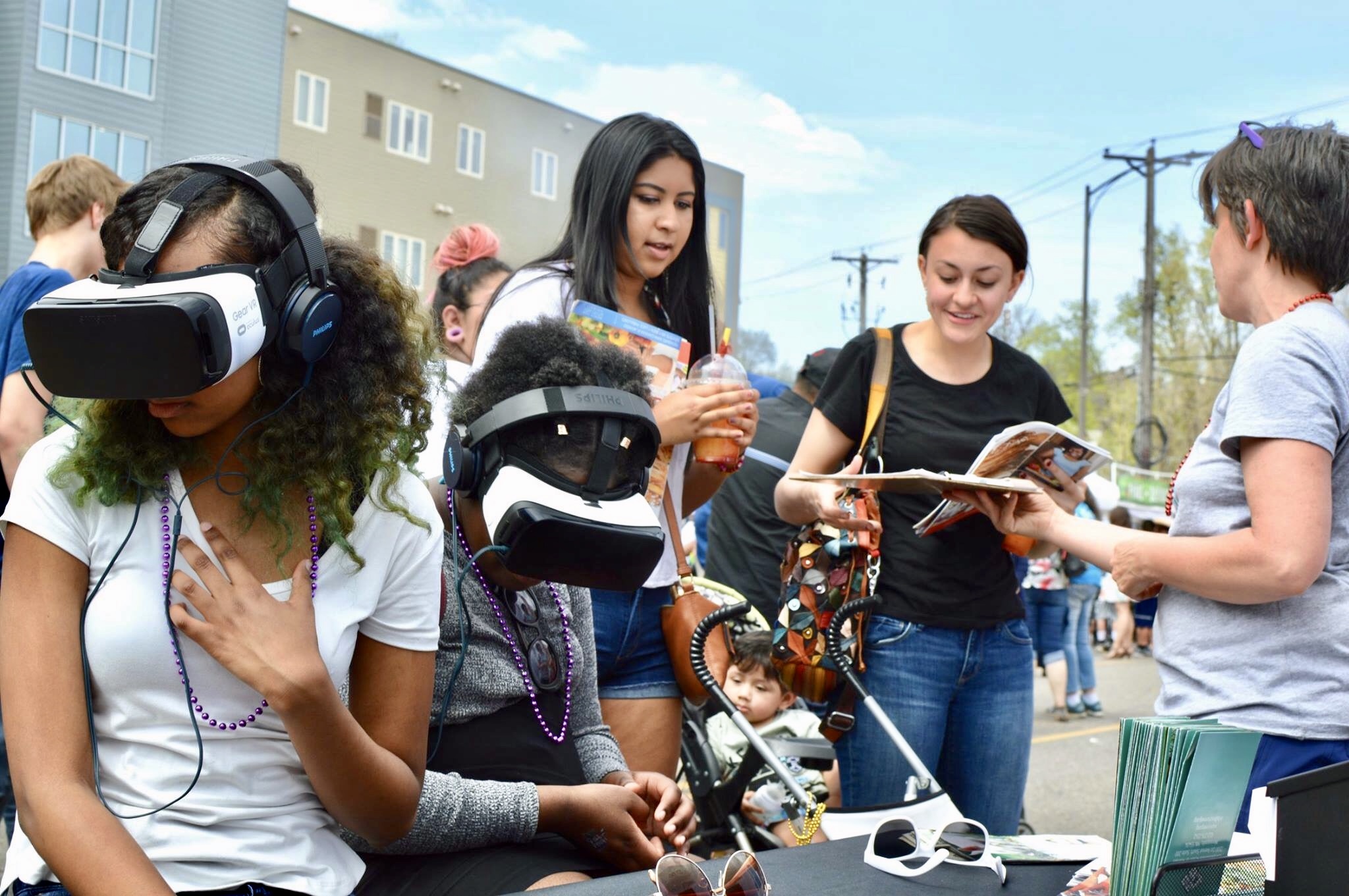You can subscribe to our blog using our RSS feed.
Pride Outreach in Pictures

Every year, CAA has a table at the Twin Cities Pride Festival, and this year was no exception. For two days in Loring Park, we leafleted and conducted video outreach on behalf of animals, and we reached a lot of people along the way. Over the course of the weekend, we gave away more than 1,000 leaflets and got more than 590 video views. Wow!
Pride is ideal venue for sharing our message of compassion. The festival itself is devoted to the idea of expanding the circle of compassion to include the LGBTQ community. The people we reach there tend to be especially open to the idea of opening their hearts to the plight of farmed animals. One festival attendee remarked, “This was the most important part of the day for me.”
Thanks to all the volunteers who helped with outreach and to Luke White for taking these photos!
Continuing Adventures in Animal Advocacy

I started volunteering for CAA in 2005, a few years after going vegan. I think my motivation was wanting to do more to help animals and also wanting to meet other vegans.
At the time, I was a professional dancer. Over the years on and off, while a dancer, I volunteered with CAA in various capacities, everything from helping out at a yard sale fundraiser to leafleting on the university campus to coordinating volunteers for CAA’s annual animal advocacy conference, Their Lives, Our Voices.
I jumped right in and found a supportive community where my vegan values were shared. I also found a positive outlet for my passion for helping animals.
“Passion” is a rather appealing word. Really, what I was feeling was sadness and rage, thinking about what animals experience on factory farms, as revealed by undercover videos. My passion grew out of my sadness and rage, and CAA gave me the opportunity to put that passion to good use, participating in a grassroots movement to liberate farmed animals.
CAA’s fundamental core values and strategy made sense to me, and I felt confident that CAA’s welcoming approach would achieve the best results in the long-term: getting the biggest number of people to sustain a move toward plant-based eating. That shift would gradually but surely ensure animals would be saved from needless suffering.
In 2014, I was about to retire from full-time dancing. Fortuitously, CAA was at the same time looking to hire their first-ever communications and events coordinator, a full-time position. I applied and got the job. (I had some previous experience in the area of communications and events planning, having written a vegan cookbook and produced my own independent performance work.)
Now my passion for helping animals was my profession. I got to spend my days writing for CAA’s blog, email news, and other communications. I also launched the annual magazine, Twin Cities Veg Living, and led the redesign efforts for a new visual brand identity. I’d like to think we’ve brought our communications up a notch since I came on staff four years ago. I also organized monthly dine-outs and potlucks, giving those in the Twin Cities area a chance to get to know others and explore vegan food options.
With a new strategic plan in place, we’ve been moving into a new phase that reflects the changing needs of the modern world, making our movement more inclusive and effective. I feel confident that this next phase will lead to another threshold, beyond which positive change for the animals will be even more tangible, more visible.
Personally, I’m entering a new phase as well, having been offered the position of associate director at Minnesota Dance Theatre. Having sustained a passion for performance as well as for helping animals, I’ll be taking that job in July, which means the role of communications coordinator will be going to someone else. Applications are due June 30, by the way!
My hope is that someone with enthusiasm and skill beyond my own will step into this role and help take CAA to the next level. I’ve seen how the changing of the guard can bring fresh energy and opportunity for new growth. Laura Matanah became CAA’s new executive director in December of 2016, and with her leadership we’re embracing a new strategic plan and growing in significant ways.
I also notice how our movement is thriving on a local level. With another vegan restaurant opening almost every other day it seems, the availability of vegan food options is increasing at exponential rates. Also, the region has a number of new farm sanctuaries that provide uplifting experiences for visitors who get to meet the rescued animals.
I see all of these new ventures as a great boon for the animal advocacy movement. Each of these advances will inspire and enable people to make more compassionate choices, and each is a component of the whole movement.
I recognize how CAA has been a catalyst for much of this action and continues to be a vital component. The work we do is not about feeling good simply for our own benefit. Our focus is on helping animals, and over the past twenty years, CAA has reached countless individuals with a message of unconditional compassion for those chickens, cows, pigs, fish, and other animals most commonly exploited as part of our food system. Through raising awareness, building community, and nurturing advocates, we’re serving our mission, we’re making this a more peaceful world for all beings.
For that work to continue, CAA needs you. CAA needs you to participate, volunteer, donate, and do what you can to support our mission to help farmed animals. Though I’m moving on from my position as an employee at CAA, I’ll be around offering my support in these ways as much as possible.
And speaking of support, I’d like to offer thanks to everyone who has supported me here at CAA over the past four years: Laura, the board of directors, and all the volunteers. You’ve been amazing! I’ve learned a lot that I’ll take with me, and I’ll keep advocating for animals wherever I go. The adventure continues.
Volunteer Shoutout: Meet Marina!

Meet Marina Kirkeide, the chair of the CAA student group on the University of Minnesota campus. Marina is a pre-med incoming senior pursuing a degree in mathematics. When this born and bred Minnesotan isn’t working to encourage compassionate choices or studying for her degree, she likes to bike, read, play video games, and spend time outdoors.
After adopting a vegan lifestyle her freshman year and joining the CAA student group her sophomore year, Marina decided to take on a leadership position within the group.
“I decided to take on a leadership role after attending meetings for a while and feeling like I wanted to do more and be a bigger part of the planning and activities,” Marina says.
As chair of the group, she is responsible for planning and facilitating the weekly meeting, coordinating activities on campus, and picking up tasks here and there to ensure that things run smoothly. She also greets new and potential members, which is one of her favorite parts of being in the group.
The group primarily focuses on providing support for students who are making the transition to plant-based eating. “It can be really hard to make dietary changes when you don’t know anyone else who is doing the same thing. We try to fill in that gap,” she says.
The group also does a lot around campus and in the Twin Cities community to encourage compassionate decision-making. Student volunteers help with campus outreach, including pay-per-view, virtual reality, food giveaways, movie screenings, bake sales, and special presentations.
When asked what her favorite part of being in the group is, Marina says, “Meeting new people and hearing their perspectives and stories about veganism and related topics. A close second would be doing projects and making art for the group. Also, for every meeting, a member of the group brings plant-based food to share, and I really like baking vegan treats for everyone.”
Earlier this month, Marina and her sister marched in the MayDay Parade in Minneapolis, bringing to life a walking cow puppet that was crafted by the student group. Marina enjoyed the parade and thinks the message was well-received; they had a lot of people cheering for them.

The group has seen a lot of growth in the past few years. When Marina’s sister was a part of the group a few years ago, they had four regular members. This past year, the first meeting of the semester saw a turnout of 75 people! To manage the unexpected growth, they restructured student roles to maintain momentum.
Each new year, the group tries to organize and engage in more events and campaigns on campus. This year, they participated in the student government committee in an effort to improve the student dining experience for plant-based eating. For Earth Day, they had a successful display at an event coordinated by the Environmental Student Association.
For the future, Marina thinks having a network of college CAA groups across the Metro area would be a great way to connect student activists and enable bigger changes. Moving in this direction, CAA added a student group at Augsburg University this past year. Meanwhile, the University of Minnesota student group continues to take off. They’ve got big plans for their involvement in CAA’s Wholesome Minnesota program, ranging from better plant-based meal options to Meatless Mondays to an all-vegan dining hall!
If you’re a college student in the Twin Cities who wants to get involved in CAA student groups, visit our campus page to learn more. (High school students are welcome, too!) Weekly meetings are currently on hiatus until the fall semester, but if you’d like to get involved in the meantime, check out our upcoming volunteer opportunities.
Vegan Ice Cream in the Twin Cities

People are often surprised when I tell them the Twin Cities has many vegan ice cream options. A few places have savory food as well, so you can enjoy a full meal all in one spot!
Crepe & Spoon | 339 22nd Avenue NE, Minneapolis
Crepe and Spoon is one of northeast Minneapolis’ newest hot spots, slinging vegan crepes that feature The Herbivorous Butcher’s meats and cheeses along with a nearly full case of coconut-cashew ice cream offerings. Flavors change regularly so you never quite know what you’re going to find, but don’t worry—you can sample before you decide. I’ve tried everything from Thai Tea to Popcorn to PB&J to Matcha. I’m convinced you haven’t lived until you’ve savored a scoop of creamy ice cream nestled inside a fresh, hot crepe.
J. Selby’s | 169 N Victoria Street, St. Paul
You’ve likely heard of J. Selby’s and their infamous Dirty Secret. My secret is that you can go for happy hour weekdays from 4 to 6pm and get $2 off appetizers and SoyClones (think: vegan Blizzard®!) and walk away perfectly satisfied. So nosh on a basket of Cauliflower Wings, then choose between vegan chocolate and vanilla soft serve; add-ins include house-made brownies and chocolate chip cookies, Newman Mint-O’s, peanut butter, and more. Or keep it simple and get a dish of soft serve on its own.

Milkjam Creamery | 2743 Lyndale Avenue S, Minneapolis
Offering five to six whimsical vegan ice cream flavors daily, Milkjam Creamery has not disappointed. If Black (dark cocoa) is available, it’s the perfect place to start, and I know many non-vegans that love it, too. The Wadi brothers who own Milkjam also own World Street Kitchen next door, so I’ve grabbed a Bangkok Burrito with crispy marinated tofu before snagging a scoop many times. In the summer, you’ll often find a line down the block, but it’s worth the wait and usually goes quickly. Also make sure to double check the Sundae Special because the offering has been vegan occasionally.
Wedge Community Co-op | 2105 Lyndale Avenue S, Minneapolis
Wedge Table | 2412 Nicollet Avenue, Minneapolis
If you’re looking for an inexpensive, small sweet treat, pop into the Wedge Co-op or Wedge Table and grab a kids’ coconut milk soft serve cone. Feeling more adventurous? Go for the Chai’s The Limit or Espresso Bomb shake. Both locations also have a selection of made-to-order savory food, and the Table has indoor and outdoor seating.
And that’s not all…
Izzy’s Ice Cream
- 2034 Marshall Avenue, St. Paul
- 1100 2nd Street S, Minneapolis
- izzysicecream.com
La La Homemade Ice Cream
- 3146 Hennepin Avenue S, Minneapolis
- lalahomemadeicecream.com
Loulou Sweet & Savory
- 2839 Emerson Avenue S, Minneapolis
- loulouandco.com
MN Nice Cream (NEW!)
-
807 Broadway St NE #102, Minneapolis
- mnnicecream.com
Pumphouse Creamery
- 4754 Chicago Ave. S., Minneapolis
- pumphouse-creamery.com
Sebastian Joe’s
- 1007 W Franklin Avenue, Minneapolis
- 4321 Upton Avenue S, Minneapolis
- sebastianjoesicecream.com
Sweet Science Ice Cream
- In stores only; no storefront
- sweetscienceicecream.com
This article was originally published in the 2018 issue of Twin Cities Veg Living.
Laura vanZandt writes the blog One Girl, Two Cities and is the Marketing Communications Coordinator at The Herbivorous Butcher.
The Circle of Care: Sustaining Change

Want to make a lasting difference for farmed animals? Consider joining our Circle of Care and becoming a recurring donor.
With your monthly contribution, Compassionate Action for Animals can continue doing the work of raising awareness, building community, and nurturing advocates in the Twin Cities region. These activities have a powerful, cumulative effect, ultimately sparing the lives of farmed animals through creating a community of individuals who make conscious, compassionate choices.
We’re sharing the stories of five such individuals today. Meet Suzy, Abraham, Yunuén, Theresa, and Sanchez. All of them are part of the Circle of Care, and they’re happy to tell you why.
Suzy Sorensen

Occupation: Registered Dietitian, Certified Diabetes Educator
What I love to do on a day off: Anything outside! Walking, working in the garden, watching birds and squirrels, reading on the porch…
Why I joined the Circle of Care: CAA has a growing positive impact on our community. Through varied activities, CAA achieves its mission of inspiring people to embrace their empathy and live more peaceful, compassionate lives. The world could use more of that. I know that being a monthly donor allows CAA to more effectively predict resources available for education, community building, and outreach efforts, allowing them to spread their message of hope and change.
Abraham Rowe

Occupation: Campaigns at Mercy For Animals
What I love to do on a day off: Sit by a lake with a good book.
Why I joined the Circle of Care: CAA doesn’t only educate people about the tremendous cruelty in our food system; it also gives people a community to come back to, opportunities to continue learning, and resources for building skills. I strongly believe that CAA’s grassroots, welcoming approach is a fundamental part of what we need to build a more compassionate world.
Yunuén Ávila

Occupation: Human Services Representative at Hennepin County
What I love to do on a day off: Literally anything that involves spending time with my husband, Sanchez Brown, and my fur babies: Pinkie, Mai Sun, and Goose.
Why I joined the Circle of Care: I give to CAA because I honestly care about educating the public about veganism. CAA opened my eyes to veganism when I was a vegetarian and helped me take the next step toward a compassionate lifestyle. Thanks to them, I’m able to spread the same message to others.
Theresa Zingery

Occupation: Community Education Manager
What I love to do on a day off: Long walk around one of the city lakes.
Why I joined the Circle of Care: I give to CAA because I feel strongly about its mission and its unique role in accomplishing very important work for the animals while helping people eat healthier for themselves and the planet. The work of CAA helps with many important issues that are interrelated, so I feel I can accomplish a lot with my donation.
Sanchez Brown

Occupation: Director of Security with G4S Secure Solutions
What I love to do on a day off: Sleep in a bit, take my dog Pinkie to the dog park and then open up one of the probably eighty different vegan cookbooks I have, pick a recipe, add my own spin on it, and use my wife as the taste tester!
Why I joined the Circle of Care: I donate to CAA because of the mission and the passion. It’s the most noble cause to defend the most noble creatures. To stand up and fight for something you believe in is so inspiring and if my donation helps to allow people to do that, I’ll never stop giving.
Sign up to make a recurring donation of any amount and help create a compassionate community in the Twin Cities and beyond.
Join the Circle of Care today!
MayDay & Cinco de Mayo in Pictures

CAA had a presence at both the MayDay Festival and Cinco de Mayo – West Side Saint Paul again this year.
At both events, we did video outreach, using pay-per-view and virtual reality to raise awareness about farmed animal suffering. Through the video outreach, we had great conversations. Some said they didn’t want eat meat anymore after seeing the video.
We also participated in the MayDay parade again this year. Our eye-catching display, created by our University of Minnesota student group, was photographed and cheered on numerous times. The walking cow puppet, brought to life by Marina and Liberty Kirkeide, charmed young and old. Marching alongside the Animal Rights Coalition, we experienced an inspiring sense of solidarity.
Here are the numbers:
| ▪ | 137 video views at Cinco de Mayo |
| ▪ | 214 video views at MayDay |
| ▪ | 309 Guides to Animal Free Eating shared |
| ▪ | 25 Spanish copies of “The Power of our Diet Choices” shared |
| ▪ | 29 Spanish vegetarian starter guides shared |
| ▪ | 18 African-American Vegan Starter Guides shared |
| ▪ | 28 copies of Twin Cities Veg Living shared |
Thanks to all the volunteers who helped to make this possible. Special thanks to Brooke Reynolds and Angelica Fabiola Vásquez Hernández for taking these photos!
Our next big outreach event is the Twin Cities Pride Festival. We hope you’ll join us for that!
We also have two upcoming training sessions which will introduce you to volunteering with CAA and teach you how to do video outreach.
- Advocate Training: Virtual Reality and Pay-Per-View
- Monday, June 4, 7 – 8:30pm
- Advocate Training: Virtual Reality and Pay-Per-View
- Thursday, June 21, 7 – 8:30pm
Interconnected: Female Oppression and the Dairy Industry

I gave birth to my fifth baby in four years this afternoon. My body is weak, but my heart is full of joy! It feels so good to have her by my side. All I want to do is frolic in this field and teach her everything. When she brushes up against me, it is all I ever want to feel. When she calls to me, it is all I can hear. The sun is going down now. I cannot remember a more perfect day.
Is that her breath against my cheek? I slept so well—much better than usual. Oh, she’s still fast asleep! I should lick her; that will wake her up. Today, I’ll teach her things to help her find me if she’s ever in trouble. What’s this? The sun is going down already? This day went even faster than the last. I know my baby will remember all she’s learned.
I’m awake and panicking! I hear gates shutting. My baby is crying, and she’s going farther and farther away. It is still dark, and I can’t see. Baby! I’m over here! Can you hear me? I can hear you! Run to me like I taught you! Keep calling until I break free. What are you doing here, human? Can you help me find my baby? Why are you keeping me here? My baby is in danger. I can’t stop calling to her. My heart has been broken open, and the pain is unbearable!
Around nine million dairy cows live in the United States. Their forced reproduction is the only thing that keeps their milk flowing. But their milk is not given to their own babies. A high percentage of dairy calves are separated from their mothers within 24 hours of birth. These new moms often bellow and cry for days in desperation and mourning. Cows are sensitive, sentient beings. Being separated from their calves isn’t something they forget quickly. And it’s all for profit and to satisfy what the dairy industry has lead us to believe about “the best” sources of calcium.
Would we do such a thing to human women for profit? Well…
Enter feminism. Suffragettes led the way. The Women’s Liberation movement followed. Ecofeminism emerged and aligned with the oppression of non-human females, particularly those being factory farmed. Postmodern feminism focused on humans. And where are we in 2018? Feminism has again embraced the animal rights movement because the reproductive freedom of both women and animals are linked to the patriarchy and other forms of oppression.
Want to engage and learn more? A great way to connect with factory farmed animals and learn about what they endure is at a sanctuary. And Spring Farm Sanctuary in Long Lake, Minnesota even has cows rescued from the dairy industry. I encourage you to pay them a visit, and remember to embrace how the interspecies oppression of females is one more reason to add plant-based meals to your plate.
“Those who seek greater justice in our world need to work toward a deeper understanding of oppression. Activists need to develop the kind of understanding that will lead to a lifestyle—a way of being—that works against all oppressions.” – Lisa Kemmerer, Sister Species
This article was originally published in the 2018 issue of Twin Cities Veg Living.
Emily Kampa is a digital copywriter, animal lover, and vegan foodie. She lives in St. Paul, Minnesota with her wife Laura and their American Staffordshire Terrier, Pip.
CAA hosts a vegan Mother’s Day potluck on Sunday, May 13. All are welcome. Join us as we honor all mothers.
Animal Advocates: Let’s Talk about Self-Care

Cultivating compassion. These two words say a lot about our work as animal advocates. Whether we are explaining our plant-based food choices at family gatherings or reaching out to the public to talk about what happens on factory farms, we aim to speak out for the animals in the best way possible. Animals suffer less when we help others grow empathy and choose more plant-based meals. But our own needs must be nourished, too. And that is why self-care is so essential.
Maintaining a conscious awareness of animal cruelty is draining, even without being on the front lines. And creating the time and space to recharge can feel like just one more thing on our to-do lists. We’re committed to nonviolence for the animals. But what does nonviolence look like on a personal level? And how will you know when you’ve achieved a good balance between advocacy and self-care? Can you keep it up? Where do you even start?
CAA believes that every advocate should have a self-care toolkit, a collection of practices and activities that support your mental, physical, and emotional health. Being intentional about which tools you select for your kit, as well as how they are used, is key. It will help sustain yourself and your activism for that long haul.
Check out these tips to help build your kit.
Cultivate a practice
A regular practice can help your mind, body, or spirit. The key is to find something you love. Need ideas? Yoga or meditation can help clear the mind and connect it to the body. Find an exercise you enjoy, which might be one you’d never thought of. Sleeping on a regular schedule and committing to limited screen time before bed can work wonders.
Plan regular visits with those you care about
Friends, family, and animal companions are obvious choices! Pencil them into your calendar. Try new things together. And knowing which people in your life understand how important animal advocacy is to you can be a huge help. Make it a habit to reach out to them regularly.
Get creative
Are you already an artist or writer? Make time for your craft. If not, try anything creative that piques your curiosity, and don’t be afraid to think outside the box! Make a music playlist that’s your go-to when you’ve had enough. Cook or bake something you never have before, or if cooking is not your thing, frozen meals and cereal can be your best friends.
Connect with other advocates
Make it a goal to build diverse and meaningful connections with other advocates. Seeing yourself in others builds comaraderie and can reduce stress. Along those lines, have you joined the CAA volunteer Facebook group?
Finding in-person events like one recently hosted by Unny Nambudiripad, one of CAA’s founders, can build connection. His Wellness Day for Animal Advocates at the People’s Movement Center attracted more than thirty people. They meditated, did qigong, got massages, discussed sustainable activism, journaled, and created a gratitude board. Participants left with a list of support resources.
You can also consider attending the 2018 Healing Retreat, designed for animal advocates and hosted at the Metta Mediation Center in Janesville, Minnesota.
Another recommended resource is pattrice jones’ book Aftershock: Confronting Trauma in a Violent World: A Guide for Activists and their Allies. Check it out!
Seek help if you don’t know where to turn
In Defense of Animals provides free mentors for activists by phone, text, email, and online chat: www.idausa.org/activistsupport.
And if you need it, call the National Suicide Prevention Lifeline 24/7 at (800) 273-8255.
Moving forward as an animal advocate, embrace compassion not just for the animals, but for yourself. We hope that these tips will help sustain your activism for many years to come, creating a world where all are free, happy, and cared for.
Meet Our New Board Member – Victor Massaglia

CAA welcomes Victor Massaglia to our board of directors. Learn more about Victor, where he came from and how he got involved with speaking out for animals and CAA.
Tell us a little about yourself, Victor.
I grew up in Rochester, Minnesota and was in the United States Air Force for about nine years as a personal administrator helping people through transition. I served in Columbus; Mississippi; Okinawa, Japan; and Honolulu, Hawaii.
I’ve been working in higher education for over 25 years and am currently the Director of the Career and Professional Development Center at the School Public Health at the University of Minnesota.
I very passionate regarding issues of human rights and believe that regardless of race, gender, faith, sexual orientation, faith, we are all equally important and that no one should be ignored. I look for ways people can work, play, and be better together.
When did you journey to being vegan begin and where has it led you?
My motivation to become a vegan started primarily as a result of a long and frustrating recovery period from a major surgery. I believe my choice to adopt a plant-based diet rebooted my life. Now, I want to give back in a positive and systematic way.
While learning about how to live a vegan lifestyle, I became more knowledgeable about where our food comes from, how animals are not honored and are continually being abused, as well as how animal-food production is negatively impacting our environment.
I am grateful to be a part of the vegan community now and believe in the power of compassion to make positive change.
How did you get involved with CAA?
From my first experience with CAA was volunteering for the 2017 Twin Cities Veg Fest. I felt a definite affinity with CAA’s mission to encourage people to cultivate empathy for animals and move toward a plant-based diet. I also felt an immediate kinship with CAA and Twin Cities Veg Fest leadership. Also, and quite frankly, all of CAA’s core values are totally aligned with my own core values.
As a new board member, what’s your vision for the organization?
I am excited about CAA taking the lead in meeting people where they are at, educating with empathy and compassion. We can continue encouraging more and more people to take positive steps toward eating a plant-based diet while creating an environment in which animals are treated with respect and dignity.
Interested in joining CAA’s board of directors? Our board meetings are open to prospective members. If you are interested in attending a board meeting, email [email protected] to find out when the next board meeting will take place.
28 Tips for Going Vegan and Staying Vegan
Thinking about going vegan? Already vegan and wanting to stay that way? Just curious how in the world someone can live without cheese for more than a day?
We’re sharing tips from 28 vegans who have been choosing plant-based for at least two years and some as long as 30 years. Wow!

































































